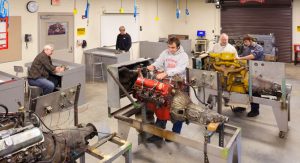With skilled trades experiencing a shrinking work force, Ford Motor Company and the UAW found the perfect employee in military vets, who number more than 10 million of the unemployed in the U.S.
 In conjunction with the Wounded Warriors Family Support Project, the UAW-Ford has launched an aggressive welding training program. A mutually beneficial initiative, soldiers returning from the front are learning employable skills that will help replenish the shortage of skilled trades experienced globally.
In conjunction with the Wounded Warriors Family Support Project, the UAW-Ford has launched an aggressive welding training program. A mutually beneficial initiative, soldiers returning from the front are learning employable skills that will help replenish the shortage of skilled trades experienced globally.
Students are selected by Wounded Warriors and attend a free six-week course designed to educate them on the skill of welding. Welding is just one of the many trades in which there will be labor shortages as baby-boomers reach retirement age. It is projected that the automotive industry alone will need 290,000 skilled welders in only 8 years, by 2022.
This trend is poised to steadily rise, as U.S. assembly plants are operating at full capacity. Military veterans are attractive to employers due to proven problem-solving skills and experience in facing adversity. Many vets also have skills that cannot be taught: integrity, dedication, and pride in their work; qualities that made them good soldiers.
Training of this sort is the bridge to joining experienced veterans in need of work and those skilled trades losing their experts to retirement in record numbers. One Navy veteran attending the Ford-UAW welding course explained this opportunity poignantly: “The possibility is exciting. This enables me to refocus…(With welding,) you can take something broken and fix it. I’m a broken person and this helps.”
The objective in hiring veterans has also spread to automotive vendors and suppliers. Andra Rush, Chairman and CEO of three manufacturing companies employing 2,700 workers in the U.S. and Canada, actively seeks out special populations when hiring. New hires include: metro-Detroiters, Native Americans, and veterans, whom Rush proudly claims make up 10% of her new hires for Detroit Manufacturing Systems. Understanding the plight of these often overlooked groups, Ms. Rush explains: “If there’s not an avenue to have meaningful work or provide for your family, I think it makes it hard to live up to your potential.”

As the U.S. reduces its military presence all over the world, the number of veterans returning home for “meaningful work” will continue to rise. As the demand for skilled trades grows, proper training will harness the talent and dedication of veterans and allow them to make their living in a meaningful way.
Other U.S. industries are also taking advantage of military-trained individuals now in the job market. State and National government have launched apprenticeship programs for construction, electricians, and cell tower maintenance. In its “Helmets to Hats” Program, the U.S. government offers schooling for 15 different trades with more than 80 apprenticeships, mainly in the building and construction industry.
Current veteran employment at Detroit’s Big Three is impressive. It has been reported than Chrysler has employs 11,000 veterans, Ford employs 14,000 veterans and GM tops the list at 20,000 veterans, employed in a variety of fields from entry-level through management positions.
Sources: Detroit News, militaryconnection.com
image 1: This veteran is one of several students enrolled in the six-week welding program hosted by Wounded Warriors, Ford, and the UAW. The goals of these programs are two-fold: employment for the veteran returning home, and educating employees to populate the dwindling skilled trade workforce. (Credit: www.detroitnews.com)
image 2: Community college and Vocational Schools are expanding their course offerings to give students an option other than traditional universities as well as building up the skilled trade workforce that is losing members to retirement and early buyouts. (Credit: www.google.com)
